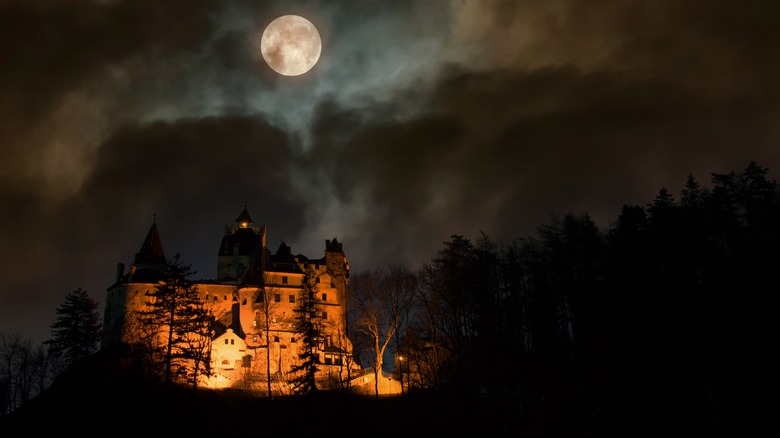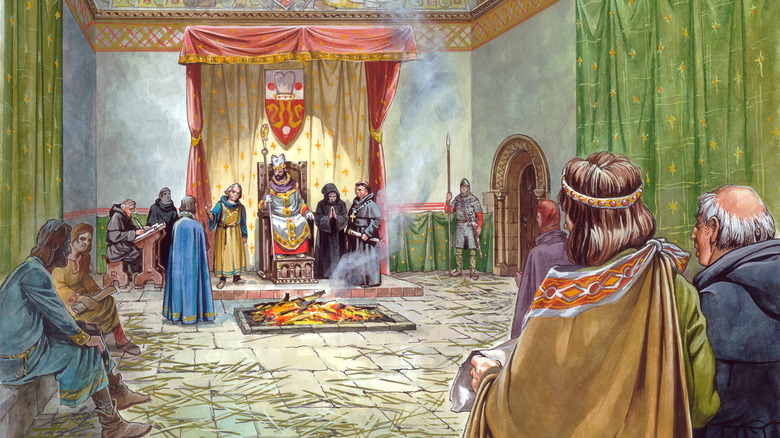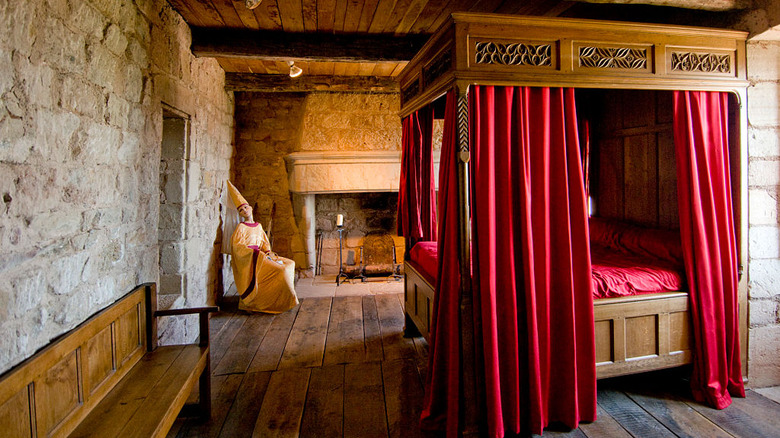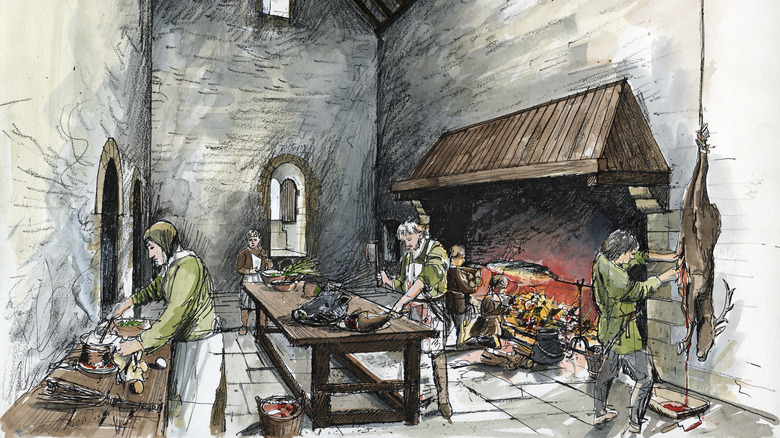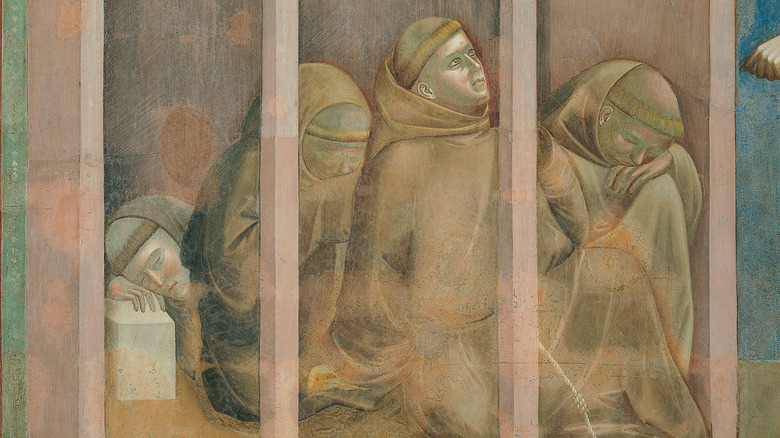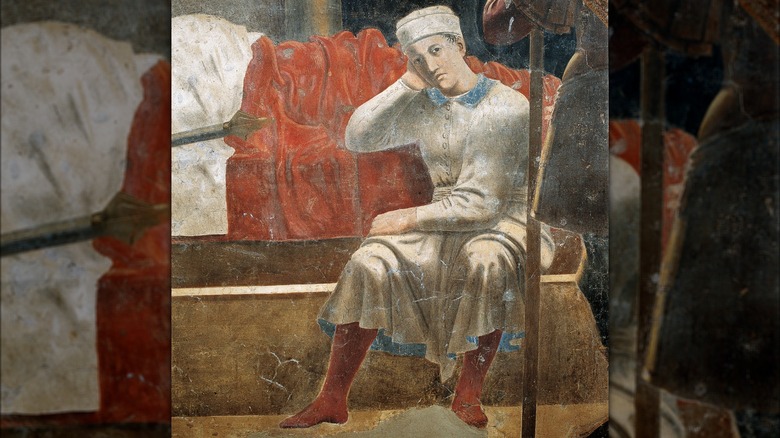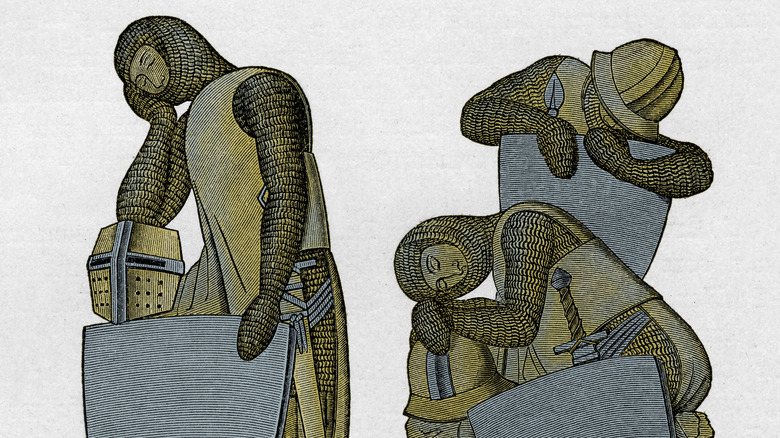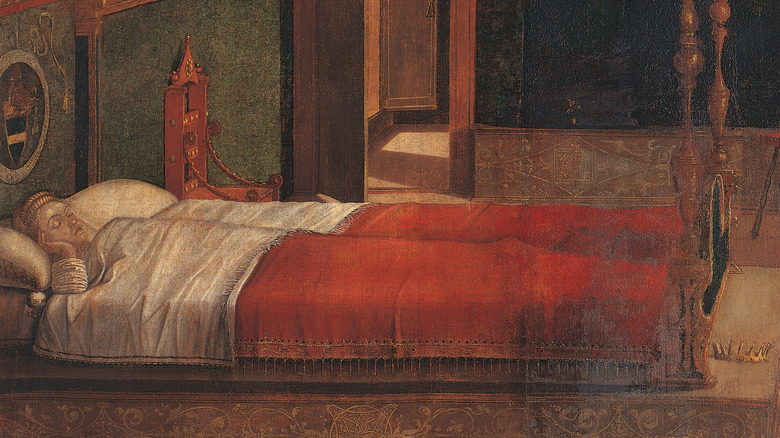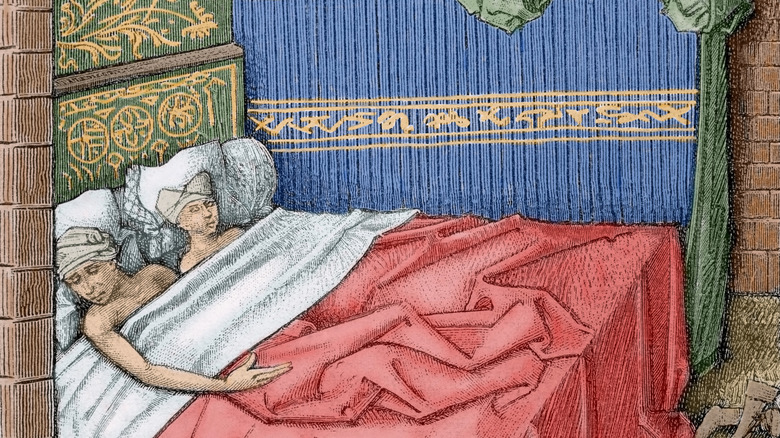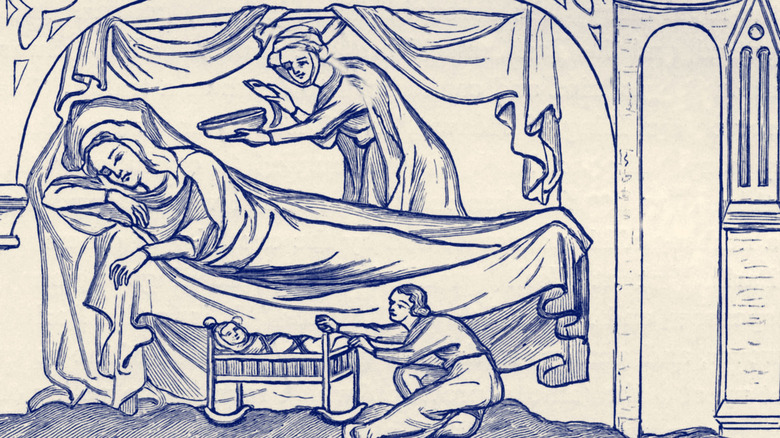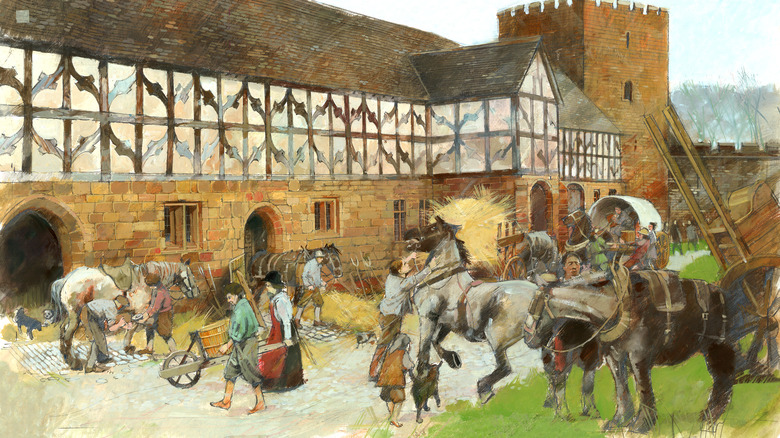Here's Where People Slept In Medieval Castles
By all accounts, people in the European Middle Ages (spanning from the 5th to 15th centuries) weren't all that different from us modern folks. You may be fortunate enough to have internet access and central heating where they did not, but otherwise, the bare facts of living remained the same. Medieval people needed to work, eat, and sleep just like anyone else. For people with straightforward homes and relatively small households, such as peasants in their cottages, figuring out where to sleep was easy. In fact, for many people, the trickiest part was deciding who slept where in the household's shared bed.
But what about castle life? Medieval nobles could have sprawling households packed full of family members, courtiers, and servants, all of whom needed a place to sleep at the end of the day. Where and how they slept within a castle said much about who they were and the kinds of lives they led. A lady or lord who had command of the castle — or even a visiting royal — could plan to retire to nice apartments with a private, luxurious bed.
Servants, meanwhile, might have had to jostle for space on a shared mattress or even accept their fate of bedding down into straw or the rushes scattered across the floor of a castle's great hall. In really crowded situations, some might have even had to wander outside the castle walls to find a halfway decent sleeping spot. Here's the reality of who slept where in medieval castles.
Early or small medieval castles didn't really have separate bedrooms
In the earliest centuries of the Middle Ages, castles could be pretty simple affairs. They sometimes had just one main living space instead of many different rooms. Known as the great hall, this part of the castle has its roots in the large, centralized buildings used by nobles and their retinues prior to (and just after) the Norman invasion of England in 1066. These early halls — think Heorot, King Hrothgrar's monster-haunted mead hall in the epic poem "Beowulf" — were gathering spots where people could party and the local king or lord showed off their wealth and made important social connections. They would have had little choice but to sleep in these early medieval halls alongside everyone else (though presumably with nicer bedclothes).
By the time the great hall made its appearance in medieval castles, the basic purpose remained the same. Great halls hosted feasts, legal proceedings, awed visitors gawking at the architectural wonders, and plenty of snoring. That last situation came about because just about everyone in early (or, in later centuries, small) castles lived much of their lives in the great hall.
Who slept where in that space typically depended on rank, even if they were all sharing one big room. The lord and lady would have retired to a bed at one end, perhaps behind a curtain. Others might use the floor, which was covered in rushes and nice-smelling herbs, which were replaced when they became dirty.
Nobles would eventually have private chambers
Though the great hall started out as one big communal sleeping area, things weren't quite so equal. The highest-ranking members of the household — namely, the lord and lady of the estate — would have probably retired to a bed behind a curtain or wood screen at the far end of the hall. Eventually, as castles grew in size, the noble family might tromp their way up to a second-floor room just above the great hall. There, they would have had more privacy, though it wasn't a two-way street: some of these chambers came with peepholes that allowed occupants to look down on the great hall and its inhabitants.
Some castles even set aside rooms for nobles in different buildings, such as a central tower that could offer extra protection if the castle came under attack. Even if they didn't get a private tower, nobles of a castle in later medieval times could enjoy an exclusive room called a solar, located on an upper level. The solar was the most likely room in the castle to contain a richly decorated bed, which was often a pricey piece of furniture in the medieval era and could include curtains for extra warmth, privacy, and showing off a household's hefty textile budget.
Even so, few nobles would have expected this space to be totally private. Beds might turn into extra seating for visitors and the entire room was likely to be used for work and socializing during the day.
More high-class sleeping areas were often away from the kitchen
Kitchens were something of a necessary evil in medieval castles. Of course, everyone needed to eat and occasions like banquets with tables loaded down with rich food were opportunities for the lord to strengthen alliances, honor religious occasions, and show off his wealth (those imported peppercorns sure weren't cheap). But kitchens could also represent a very real and deadly danger to a castle's inhabitants. In an era before electricity, medieval cooks had no choice but to use fire, which was an obvious issue in early wooden castles. Things improved when castle builders turned to stone construction and grew even better when open hearths transformed into more enclosed fireplaces that were set into a wall. This made it easier to stomach having a kitchen close to the hall, though extra-hot ovens were still sometimes constructed separately and placed outside.
Even so, some castles situated sleeping quarters for higher-class folk farther away from the kitchens. At Goodrich Castle in 13th-century England, the nicest spots (including what were likely rooms for the powerful Countess Joan de Valence) were the farthest from the fiery kitchens, as was the case for other castles at the time. Everyone else had to make do with accommodations wherever they could get them, which ranged from nice rooms not far from noble digs to temporary structures just outside the walls. Lower-ranking servants probably weren't given the luxury of worrying about sleeping close to the fire risk of the kitchen.
Servants might have slept all together
While the ladies and lords of a castle might retire to their well-appointed solar for a modicum of privacy, few servants would have gotten that same sort of luxury. When bedtime approached in a medieval castle, they were more likely to find a spot in a shared space, whether that was the great hall of the manor, a communal room somewhere in the attic, or even down in what could have easily been a dark and dank basement. Higher-ranking servants would at least get a mattress, and maybe even one filled with soft, warm feathers. However, they were almost certainly expected to share that mattress with other servants in order to maximize space, regardless of snoring issues or anyone who had the tendency to flail about while sleeping.
Some accounts indicate that, at least in a few medieval castles, servants might have gotten a sleeping spot above or very near the kitchens. While some may have worried about snoozing so close to a pretty clear fire hazard, it's easy to imagine that these spots were especially nice during frigid, wet winters, when the residual heat of the place could have staved off the bitter cold well into the night. At that point, it may have been worth packing into what could have been relatively cramped quarters, regardless of the snoring that might have been going on.
Other servants slept in the bedroom with their boss
You might think you'd want to be a medieval servant of the upper ranks, at least compared to the lowly drudges who scrubbed pans in the kitchen or cleared out the stomach-turning contents of castle cesspits. In fact, some sufficiently high-ranking servants were considered to be nobility or at least quasi-nobility. Yet, while there certainly were perks both material and social that came with waiting directly upon castle-holding nobles, that came at the cost of often working in very close proximity to the lord or lady. For anyone who has a less-than-pleasant medieval boss and no such thing as a union or occupational safety laws, things could have gotten unpleasant in short order.
It wasn't just that valets and similar servants had to attend to the lord while he did his business in the castle toilet (at least that later evolved into a plum royal assignment for the Groom of the Stool). Many were also expected to snooze in close proximity to him, too. The evidence? Beds. Some medieval accounts of large households refer to truckle or trundle beds, small sleeping surfaces that would have been tucked away under a larger bed during the daytime. At night, servants would pull out the bed and sleep in them so that they could be close in case their (hopefully undemanding) master needed anything, even in the middle of the night. In other castles, they might be expected to sleep on a nearby bench.
Knights slept in dormitories or near their posts
Though medieval knights are often thought of as being on the move, such as gallivanting through the countryside or charging out on one of the eight different medieval Crusades, it was also possible that they were part of a castle's full-time staff. In this more settled position, they would have been tasked with defending the castle, perhaps by more specifically protecting the lord or more generally roaming across his lands as signs of his power (and the occasionally brutal ability to enforce it). They might also be part of a larger group of soldiers that could include young pages who were knights in training.
When it came time to sleep, knights might go to bed in communal barracks, especially if they were housed in a large castle with space set aside for a defensive force. Few records are clear here, but some castle financial accounts note that money was set aside to house resident knights in accommodations that were separate from everyone else's.
Otherwise, knights might have had to make do with any number of different castle accommodations, which could include whatever rooms were available, a hastily constructed structure just inside or outside the castle walls, or the old classic of bedding down for the night in the great hall. Some knights and soldiers might even have slept where they were stationed in the castle, making it sound an awful lot like curling up for a nap beneath your work desk.
Royals expected seriously nice castle rooms
In medieval Europe, many royals were seemingly always on the move. Often, the entire court was expected to pick up and move whenever necessary — probably a serious relief for whoever last hosted the hungry, expensive crowd. English kings traveled less than their continental counterparts, but it was still a feature of court life in medieval Britain.
In royal castles, the king could have some of the most splendid bedrooms of all. In the 13th-century Tower of London, Edward I had an especially nice sleeping area, which has been recreated in modern times to show off the spendy curtained bedstead, abundant textiles, elaborate wall paintings, and dedicated fireplace that would have kept one of the highest-ranking people in the country nice and cozy.
The flip side of having a royal castle is that it could also house annoying guests who took their time leaving. Friends and family of the king could stay in a royal castle at the whim of the king, with the local sheriff and castle constable under orders to look after them. This was an especially attractive option for highborn families whose protector was going to be away for an extended period of time and who wanted a relatively safe place to lie down their heads. Even noble prisoners of war could enjoy the relative comfort and safety of a castle bedroom. However, given the annoyance and expense of hosting people in the castle, some officials weren't sad to see them go.
The quality of beds varied by rank
Once night fell and everyone was shuffling off to the various parts of the castle where they would sleep, they would hardly expect to have the same sort of surface to snooze on. In the Middle Ages, beds could be seriously expensive pieces of furniture that were often reserved for the upper classes, though middle-class folks could put together a decent enough (if simple) bedstead. Beds would have come with mattresses that were stuffed with all manner of things, from relatively spendy feather mattresses to ones stuffed with cheaper and more available materials like straw, bits of discarded textiles, and wool.
Amongst the servants, the quasi-nobles that worked in positions like those of the pages might have a nice enough spot on a feather mattress, though they would have been expected to share their bed with other servants. The lowest-ranking people in a castle and medieval society at large might not even get the comfort of a prickly straw and hair-stuffed mattress. Instead, they might have had to make do with nestling down directly into straw — hopefully a thick enough layer to at least insulate them from the chilly, hard ground or floor. Even servants who had mattresses would have been tasked with stowing them during the day, especially if they had picked a sleeping spot in an otherwise public space like the castle's great hall.
Noble women sometimes had private bedrooms
In the later decades of the Middle Ages, the poshest of the posh women might have scored their own sleeping quarters. Medieval literature occasionally mentions women who control access into and out of private sleeping spaces. For instance, the medieval legend of Melusine centers on a beautiful woman who forbids her husband from entering her room one day a week. He peeks and sees that she transforms into a half-snake creature during her private time. Melusine flies off, in part because her husband has crossed into her private space. It's hard to imagine Melusine pulling that off in a peasant's cottage, so it follows that only high-ranking women might have gotten their own castle bedchamber.
Women might also have slept in semi-private spaces in the castle during a very particular time: just before and after childbirth. Of course, anyone who's given birth or had an infant in their lives knows that sleep at this point is a rare commodity. But, there was often a bed involved and a recovery period (which hopefully included some sleep) was part of the deal. Still, it wouldn't have been strictly private, as medieval childbirth was often attended by a bevy of women, including a midwife, relatives, and servants. At least in upper-class homes like a castle, the room would have been cleaned ahead of time and decked out in the nicest textiles — not that a mid-labor mother was apt to care about that sort of thing.
A few people slept in a castle's outbuildings
Not every space in a medieval castle was comfortable. While the nobles might snuggle into warm and relatively soft feather mattresses and draw heavy curtains about them, the lowliest of servants would have to make do with finding a spot in a drafty corner or crowded shared quarters. But some people might have looked on them with a twinge of envy because at least those folks were inside the castle.
Sometimes, the number of guests and workers in a castle simply exceeded the capacity of the building. If all of the bedrooms (and halls, basements, stairwells, and any other nook that could reasonably hold a sleeping human) were taken, they would have to move outside the walls. This could mean quasi-temporary structures were the only places they could sleep, including tents.
During periods of travel, grooms who took care of a group's all-important horses were known to sleep near their animals in the stables. It stands that some may have continued the practice while their group was visiting a castle. Compared to sleeping in a potentially drafty lean-to or next to a demanding noble, taking in the odors of a sturdy stable probably wasn't so bad.
